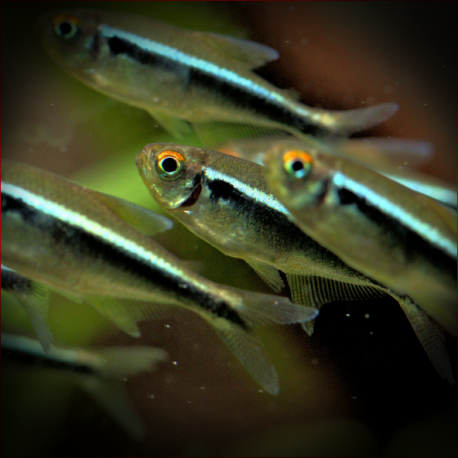More info
Datasheet
| Minimum Tank Size | 96 litres / 25.36 US gallons |
| Maximum Size | 3.5cm / 1.38inches |
| Temperature | 20°C / 68.00°F - 28°C / 82.40°F |
| Hardness | 1.01dgH / 18ppm - 12.05dgH / 215ppm |
| pH | 5.0-7.5 |
General Description
The Black Neon Tetra, scientifically known as Hyphessobrycon Herbertaxelrodi, is a popular aquarium fish known for its distinctive color pattern. This species is commercially bred in various countries, making wild collection unnecessary. It can be differentiated from related species based on specific anatomical features such as body depth, maxilla size, and scale count.
Aquarium Setup
For optimal care, it is recommended to maintain Black Neon Tetras in a community aquarium with similarly-sized peaceful fish such as characids, gasteropelecids, and small cichlids. A mixed-sex group of 8-10 individuals is ideal, along with other schooling fish for security. Tank setup should include sandy substrate, driftwood, plants, and dried leaf litter to mimic a natural habitat.
Behaviour
Known to be very peaceful, the Black Neon Tetra thrives in community aquariums. It exhibits schooling behavior, especially when kept in groups. Providing a secure environment with appropriate tank mates enhances their natural behavior and reduces stress.
Feeding and Diet
Black Neon Tetras are likely omnivorous, feeding on small invertebrates, algae, and fallen fruits in their natural habitat. In captivity, they can survive on dried foods but show better health when given a varied diet including live and frozen foods like bloodworms, Daphnia, and mosquito larvae.
Reproduction & Dimorphism
These tetras are egg-scattering free spawners with no parental care. To encourage breeding, setting up a separate breeding tank with dim lighting and suitable spawning sites is recommended. Sexually mature females are slightly larger and deeper-bodied than males.
Habitat and Distribution
Native to the upper rio Paraguai in Brazil, the Black Neon Tetra is found in minor tributaries, headwater rivers, and inundated floodplains. They prefer clear, slow-moving waters with abundant aquatic vegetation. This species has also been introduced to other regions in Brazil through the ornamental trade.

